Paladin Spells
When you think of spellcasters, chances are the first thing that comes to your mind isn’t paladins. In fact, when you think about paladins and spells, if you’re anything like me, most likely you think something like “Why do paladins even have spells? They get so few, and have such limited selection, that there’s hardly any point. Besides, if I wanted a holy spellcaster in armor, I’d use a cleric!”
All of that’s true, and, in my experience, most people feel that paladins really need to do one of two things: either get rid of their spellcasting in favor of something that feels a little more useful and meshes better with the rest of the class (such as various alternate class features or archetypes), or else get a whole lot better at spellcasting.
Obviously, most of the legwork in removing or improving a paladin’s spellcasting ability is the purview of archetypes, and therefore of Best in Class articles, but another major component is ensuring paladins have access to quality spells. The sorcerer/wizard spell list in the core rules is 7 pages long, and clerics and druids get about 3 pages each, while paladins get less than 3/4 of a page. But we’re here to lend a little magical support to paladins with some new spells made specifically with them in mind.
Armor of the Champion
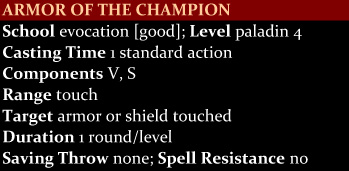
This spell allows you to channel glorious divine power into your armor (or, at your discretion, your shield). The armor acts as +5 light fortification armor (+5 enhancement bonus to AC, 25% chance of ignoring sneak attack or critical hits). It also emits a magic circle against chaos effect (as the spell). If the magic circle ends, the armor creates a new one on your turn as a free action. Additionally, all allies within the area of the magic circle spell are treated as though you had cast shield other on them (they gain a +1 deflection bonus to AC, a +1 resistance bonus to saves, and take only half of the damage dealt to them, the other half being dealt to you).
The spell is automatically ended 1 round after you lose contact with the armor or shield, and you cannot have more than one armor of the champion at one time. If this spell is cast on a magic shield or a suit of magic armor, the powers of the spell supersede any that the item normally has, rendering the normal enhancement bonus and powers of the item inoperative for the duration of the spell. This spell is not cumulative with any other spell that might modify the armor in any way. This spell does not work on artifacts.
Demon Slayer’s Sword
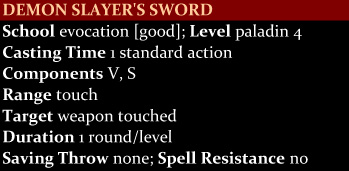
This spell allows you to channel divine wrath into your sword, or another melee weapon of your choice. The sword acts as +4 holy evil outsider bane weapon (+4 enhancement bonus to attack and damage rolls, and additional +2 to attack and damage as well as an additional 2d6 damage against outsiders with the evil subtype, and a further 2d6 additional damage against all evil targets). Additionally, any evil outsider with the extraplanar subtype that is reduced to 0 hit points by the sword is banished to its home plane (as the spell banishment), and cannot return to the plane it was banished from until a year and a day is passed (no save). This functions whether the creature actually dies as a result of being reduced to 0 hit points or not, and even if he dies and is somehow returned to life, the banishment effect remains.
The spell is automatically ended 1 round after the weapon leaves your hand, and you cannot have more than one demon slayer’s sword at one time. If this spell is cast on a magic weapon, the powers of the spell supersede any that the item normally has, rendering the normal enhancement bonus and powers of the item inoperative for the duration of the spell. This spell is not cumulative with any other spell that might modify the weapon in any way. This spell does not work on artifacts.
Pierce Glamer
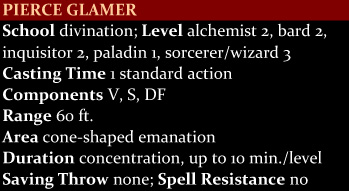
This useful spell functions similarly to detect evil, except that it is used to detect and see through glamers, rather than to detect sources of evil. As with detect evil, the amount of information revealed depends on how long you study an object, person, or area.
1st Round: Presence or absence of glamers.
2nd Round: Location of individual glamers (which creatures or objects are glamered).
3rd Round: After three rounds of study, you can see through the glamer, viewing (or feeling or hearing or tasting, as appropriate) the subject as they really are. The glamer remains apparent to you, but seems hazy and insubstantial, and is easily identified as fake or ignored entirely.
Note that this spell only allows you to see through illusions of the glamer subschool. Other illusions (such as figments and phantasms) are unaffected. Further, the spell does not actually disturb the glamer, and others continue to perceive the glamer even if you don’t.
Each round, you can turn to look for glamers in a new area. The spell can penetrate barriers, but 1 foot of stone, 1 inch of common metal, a thin sheet of lead, or 3 feet of wood or dirt blocks it.
Righteous Light
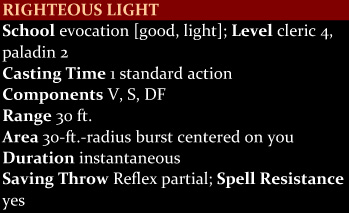
A brilliant white light of holy energy explodes from your body in every direction, surrounding you with heavenly radiance. This light blinds creatures in the affected area, and affects evil creatures more strongly. All creatures in the area must succeed on a Reflex save or be blinded for 2d6 rounds. Good creatures gain a +4 bonus on their saving throw, and evil creatures suffer a -4 penalty on theirs. Even creatures who succeed on their saving throws are dazzled for 1d4 rounds. Creatures immune to sight-based effects are immune to righteous light, and you are immune to the effects of your own righteous light.
Sword of Light
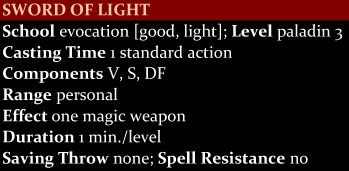
With this spell, you create a weapon made of pure, brilliant energy. Despite the name of the spell, sword of light can create any type of melee weapon (such as a dagger, quarterstaff, greataxe, ranseur, etc.). The created weapon acts as a normal weapon of its type, with a few exceptions.
First, the sword of light overcomes damage reduction as though it were magic, good, and lawful. Second, the sword of light deals additional damage based on the wielder’s Charisma, rather than his Strength, although the wielder still uses his Strength score when calculating his attack bonus with the weapon (for example, a 10th-level paladin with a sword of light in the form of a longsword, a Strength score of 14, and a Charisma score of 18, would have an attack bonus of +12, and deal 1d8+4 damage on a successful hit).
The sword of light cannot be disarmed or sundered. If you lose contact with the sword for any reason (such as by putting it down or handing it to someone else), it vanishes.


